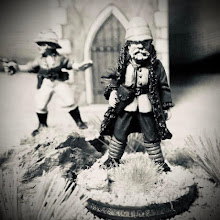The battlefield conditions of the Last War saw the introduction of the power suit as a way to protect the infantryman to a suitable degree. The ubiquitous power suit and its variants was the closest thing that generals got to the universal dream of a one man tank. By the end of the 20th century, infantry was already eclipsing the MBT in terms of cost and battle field effectiveness. The infantryman of the late 21st century was not much different than his predecessors, but his equipment was like nothing seen in history.

In order to survive the super fluid nuclear battlefield of the Last War, a infantryman had to be extensively and expensively protected. All sides researched various forms of AHAS or Advanced Human Amplification Systems. These doctrines and technology branches would not only increase the survival of an individual soldier on the battlefield, but would turn one power armored man into a hundred non-powered soldiers from just a hundred years ago. A single MI soldier, properly trained, and equipped with the standard power suit and all associated equipment and weapons, was easily the match of a 20th century First World platoon of normal infantry. The downside was, the MI trooper cost fully half as much as a 20th century First World infantry platoon! The one man tank, a dream realized on the 21CB, was simply good old force multiplication at work, at least in theory. In actual practice, very few non-MI or non-power armored soldiers survived the Last War completely intact. The 21st century battlefields were not for the thin skinned or the slow. The 21st century battlefields belonged to the armored and the quick.

Each squad was composed of a "advance point watch" (APW) position occupied by a soldier wearing a standard suit with intel/recon packs attached. In 2072, the standard suit was replaced in each squad with a lighter, more mobile scout class power suit. Three drones were dedicated to the APW position, and assigned to the support of the intel/recon packs which the APW solider humped with them.The APW was responsible for plotting the best points of movement, identifying signs of the enemy, looking out for ambushes, and keying in all possible points of cover that the squad might could use. Most of this was done automatically by the point watch support (PWS) wearing a standard suit and acting as backup and guard to the point watch, two heavy weapons operators and support specialists (HWOSS) wearing enhanced suits, and a Corporal, in charge of the whole squad, wearing a command suit. Drone distribution was usually three drones for the Corporal, three drones for the point watch, and two drones apiece for each of the other suits. The point watch, point watch support, and Corporal all carried Ibarras. The heavy weapons operators and support specialists carried the big Thompson T4D weapons systems.
The modular design of the Combine power suits and later the Paneuropean power suits allowed a variety of additional modules to be plugged into the suits according to mission. The term 'modular' was somewhat of a misnomer, as the modules could not be installed or removed short of a barracks and an hour or two, but the design did allow the suits to be rapidly updated and even modified to some extent based on mission specific profiles.
Standard field arm for squad positions One, Two, and Four was the tried and proven M35 DIWS Ibarra mass driver repeater. The Ibarra, produced under contract by American General Motors (AGM), was a very well balanced weapon system, designed from the start as a integral part of the SLICS system. Squad positions Three and Five were designated as support slots and as such, were equipped with the big, semi-portable Thompson T4D spread bore fluid to gas injected pseudo-recoilless mass repeaters which were fully integrated into the SLICS and PLIEADS system.

The Ibarra was equipped with the SCRIBOL language system, and integrated easily into any position, meaning that one soldier could be disabled or combat casualty and if the Ibarra survived, it could be picked up and utilized by another member of the squad. The M35DIWS was capable of adding its own electronics abilities to the squad as a whole, and the three squad based M35DIWS worked to enhance not only squad detection ranges, but also squad defense and point defense capacities.
The weapons of warfare drew upon mythical names. The Cybertanks were known as OGREs, other models as Fencers, Dopplesoldners, Ninjas, and the Japanese even had their own classes and names for their particular versions of the RDF CLAWS. The infantryman was no different, and probably more colorful. Faced with the ever increasing complexity of his power suit and his battle kit, the poor infantry looked way back into the mists of legend to draw colorful names for their equipment. The cybertanks may have been called 'OGRES', but the powered armor of the infantry had a more colorful name.
Soldiers in full suit were often called Trolls.









No comments:
Post a Comment